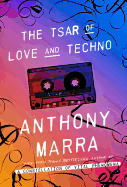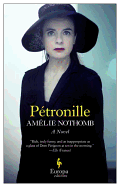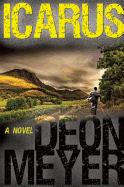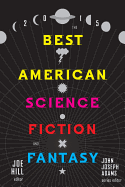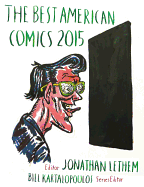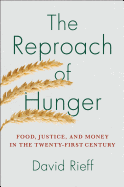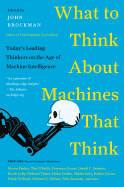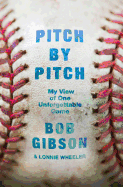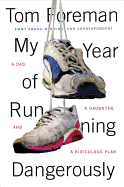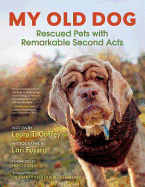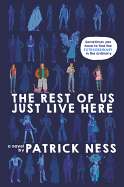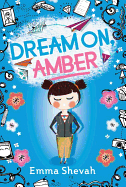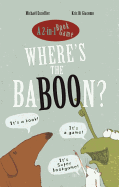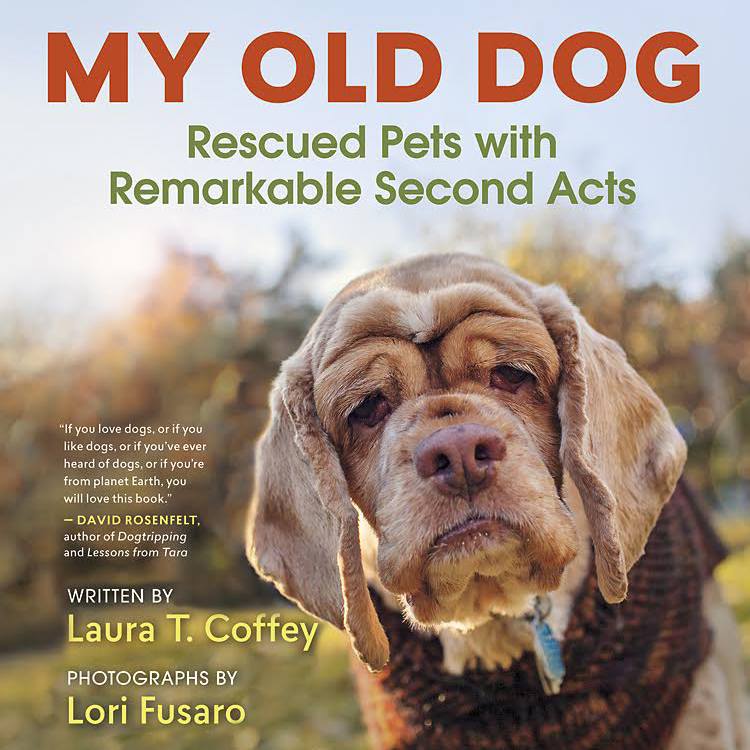 It started with dog-crazy photographer Lori Fusaro, of Culver City, Calif. After overcoming the fear of soon losing a recently adopted older pet, her family welcomed 17-year-old Sunny. A photo project featuring senior shelter pets followed, and journalist Laura T. Coffey, from Seattle, Wash., picked up the story for the Today Show website, where she is a writer, editor and producer. My Old Dog: Rescued Pets with Remarkable Second Acts is the book that grew from their shared passion (see our review below).
It started with dog-crazy photographer Lori Fusaro, of Culver City, Calif. After overcoming the fear of soon losing a recently adopted older pet, her family welcomed 17-year-old Sunny. A photo project featuring senior shelter pets followed, and journalist Laura T. Coffey, from Seattle, Wash., picked up the story for the Today Show website, where she is a writer, editor and producer. My Old Dog: Rescued Pets with Remarkable Second Acts is the book that grew from their shared passion (see our review below).
How did you identify the organizations and the individual dogs to feature in the book? Was it difficult to choose the stories to include?
Laura T. Coffey: It was difficult because so many wonderful people are doing so many wonderful things for dogs! Narrowing down the stories basically required old-fashioned reporting. I wanted a mix of very different stories--really to show that anyone anywhere can do this kind act and take in a dog who has run out of options simply because of its age.
In addition, each story needed to have a genuine story arc. These had to be stories of transformation--not just for the animals involved, but for the humans as well. I also sensed how disastrous it could be if the stories were sappy or smarmy or overwrought.
So, bearing all of those criteria in mind, I consulted with many reputable, longstanding animal welfare groups nationwide and followed up on their successes. I revisited story subjects from my job with Today.com, and pursued great people and dogs Lori originally met through her photography work. This led to tremendous variety: My Old Dog features a police officer, a schoolteacher, a machinist, a novelist, a photographer, a veteran with PTSD, a widow, nursing home residents, nuns, 20-somethings launching careers in New York City, and many more people with interesting circumstances. And, as an unexpected thrill, some celebrities agreed to participate, and their stories are amazing!
.jpg) |
| Laura T. Coffey (photo: Lori Fisaro) |
You cover organizations nationwide. Was that intentional, to illustrate that the "senior dog rescue" movement is spreading?
Coffey: Yes, that was absolutely intentional. Just a decade ago, senior shelter animals rarely got adopted, but that really has been changing. We wanted My Old Dog to reflect this growing, grassroots movement across North America and around the world. Our biggest hope is that the book will give people all sorts of ideas about different ways to help older dogs--and older cats, too! The tips and the extensive resource guide at the back of the book should be great idea generators even for people who aren't in a position to adopt or foster any pets at the moment. Our dream scenario would be that the book might inspire senior rescue groups in communities where there are none right now.
The book's organization is so inviting, with each dog's story brief, but in-depth at the same time. Did this layout come naturally or did you consider other formats?
Coffey: This approach came naturally to me because of the decades I've spent in journalism. I'm hard-wired to do two things: find real, authentic stories and avoid wasting readers' time. It was so important to me that each story really move, and of course, Lori's photos are irresistible. I wanted the chapters in the book to be like a bag of potato chips, where you'd want to read one more! And then just one more! But I also wanted the chips to be substantial and healthy--maybe like kale chips?
The big guy on the cover: Was it hard to choose from among the many rich characters in the book?
Coffey: That dog on the cover is actually a not-very-large female cocker spaniel named Stacie, and Lori's photo of her is beyond amazing. As Lori always does, she captured the entirety of that dog's personality and quirkiness and specialness. For months, though, Lori and I imagined that other dogs might end up being the cover dog. Maybe it would be an active senior dog running or catching a ball? Maybe it would be a sleepy-faced couch potato? But the design team at our publisher, New World Library, wound up seeing the incredible potential in Stacie's face. She has such a human face--it's arresting! She somehow looks wise and funny and cantankerous and sweet, all at the same time. Our hope is that readers will see that face and discern the spirit of the entire book.
Tell us about your pet family. How do you "cap" the number of creatures you adopt, when you so obviously cherish all you meet?
Coffey: Right now we have two big dogs--both about 95 pounds--and they don't think they're old at all! Frida is 11, and her face is all white, but she still loves to run like a wild woman at the off-leash dog park. Manny is 9, and he's always ready to party. We also have a huge 14-year-old cat named Diego, and we're very close to welcoming a "final refuge" foster dog from Old Dog Haven, an organization near us in Seattle which places senior shelter dogs in permanent foster homes for the rest of their lives. It's the largest rescue group of its kind in the United States. Actually, the cut-off for me will be my ability to give everyone the proper attention and care that they need.
.jpg) |
| Lori Fusaro (photo: Rita Earl) |
Lori Fusaro: I have two dogs, Gabby and Mr. French, and two cats, Francis and Enzo. Gabby, 14, is a "foster failure" who we've had for about 10 years. She fit so well with our family (just two cats at the time) that we couldn't let her go. Mr. French is also a foster failure, but we got him just for Gabby, who was very sad when our senior rescue dog Sunny passed away. Mr. French had been at the shelter for more than a year. He's very shy, and 8 to 10 years old, so many potential adopters looked right past him. That tugged at my heartstrings. He also has fatty tumors and occasional seizures. All of these things made people hesitant to adopt him--and made him perfect in my eyes. He and Gabby hit it off immediately and the rest, as they say, is history.
It's so hard not to bring them all home, that's for sure. I have fostered many strays and found homes or rescue groups for them, and recently started fostering hospice cats, who are a bit easier at that advanced age, and really need a place to spend their last weeks. It's been something that has made my heart happy. As for who we adopt, the rule is that they have to fit with the existing animals.
Lori, what tips can you give to those who would love to have even one photo of a pet as touching as all of yours are?
Fusaro: First, take it slow. Be prepared to set aside at least an hour to photograph your dog. Second, recognize that natural light is by far the very best. When you plan your photo shoot, bring your dog's favorite chair over to the window to get that wonderful sun shining in. Remember to take off your dog's collar, harness and leash! Nothing looks worse than a cute pup with all that apparatus. Or, give a fancy collar a try. Another really cool thing to do is to get down on your dog's level. The hardest part about being on the ground will be him wanting to come investigate you! Use a zoom lens to get in really close on his face.
If you absolutely have to use flash and you have one that you attach to your camera, point the lightbulb portion at the ceiling. This is called "bouncing" the light and makes a photo with soft, even light. If you only have the flash built into your camera, tape a piece of wax paper over the entire flash bulb. This mimics a "diffuser," and the light will be less harsh and the shadows much softer.
Pay attention to your backgrounds. Simple is always best. Green grass or a sandy beach really make your dog pop. Get rid of patterned blankets, beds and throws.
Treats and toys are a must. Use those special treats your dog will do anything for, or give your dog a nice bone to chew. When you're ready to take the shot, squeak a toy and watch for the most adorable, quizzical look! And my secret weapon? Peanut butter. Give your dog a mouthful and he'll sit still while he tries to eat it. It makes for some amazing tongue shots. --Cheryl Krocker McKeon, manager, Book Passage, San Francisco
Lori Fusaro and Laura T. Coffey: Saving Senior Dogs
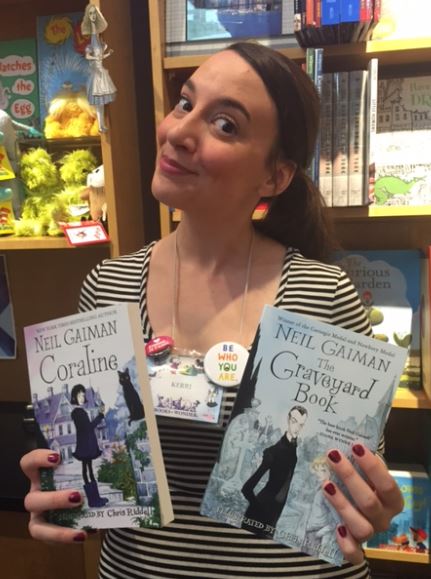




 It started with dog-crazy photographer
It started with dog-crazy photographer .jpg)
.jpg)
